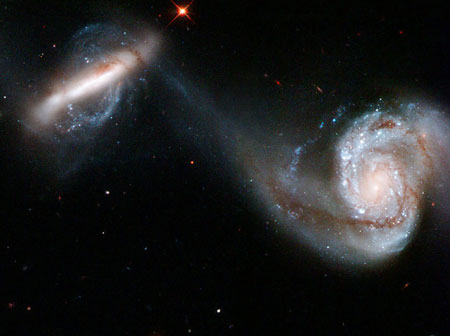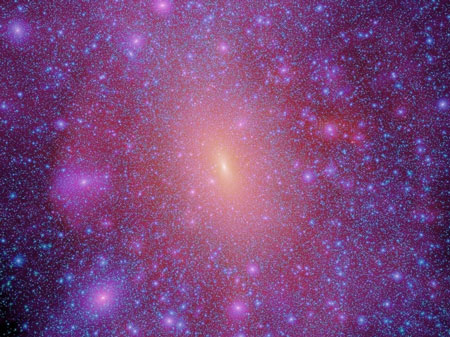| May 13, 2014 |
The first building blocks of the universe
|
|
(Nanowerk News) The first galaxies evolved only a few hundred million years after the Big Bang. But why do they have such a great variety of shapes and structures? How did the universe evolve as a whole? Two German-Chinese Partner Groups at the Max Planck Institute for Astrophysics in Garching are using observations and simulations to investigate how the early universe evolved: Cheng Li and Guinevere Kauffmann, as well as Liang Gao and Simon White.
|
|
They can be large or small, red or blue, extremely massive or just bright, can be individuals or simply follow the crowd: The galaxies in the universe come in almost all conceivable shapes and sizes. The cosmological standard model, which describes the evolution of the universe, does not really provide for such a variety, however. The theory states only that minute density fluctuations shortly after the Big Bang must have been responsible for distributing the mass and energy in the universe.
|
 |
|
Amongst other things, the researchers are investigating Milky Way systems, such as the galaxy couple arp. 87. The bridge is strong evidence that these two immense galaxies are interacting and merging. (Image: NASA, ESA and the Hubble Heritage Team,STScl/AURA)
|
|
“This results in a very useful, very simple picture of how the universe evolved,” says Cheng Li, professor at the Shanghai Astronomical Observatory of the Chinese Academy of Sciences. “But in reality, we come across, in this simple and beautiful universe, a surprisingly high number of different types of galaxy.”
|
|
Within the framework of a Partner Group together with Guinevere Kauffmann from the Max Planck Institute for Astrophysics, Li wants to resolve this apparent contradiction. The most important question here is: How did the different galaxies form and what were their fundamental building blocks?
|
|
In the search for answers, so-called surveys play an important role – sky surveys where a telescope focuses its sights on a large region of the universe step by step. The Sloan Digital Sky Survey (SDSS), for example, has observed and mapped more than one million galaxies in the vicinity of the Milky Way. This involved dispersing the light captured from each object into its different wavelengths.
|
|
In these spectra, lines show up – fingerprints that disclose, among other things, which elements are in the galaxy, how much metal the stars contain, how old they are and how quickly they are forming. “A great deal of information on the properties of a galaxy can be gained from one of these spectra,” says Cheng Li.
|
|
Li began to analyze these data together with Guinevere Kauffmann back in 2005, when he was still a postdoctoral student at the Max Planck Institute for Astrophysics. They concentrated on searching for correlations with the environment in which the galactic systems are found. One of their findings was that galaxies with a large number of stars often turned up in a so-called galaxy cluster – a region with a particularly high density of galaxies.
|
|
The SDSS spectra have one disadvantage, however: They have all been recorded in the range of visible light and thus show only stars. “Although galaxies are made up of these stars, the stars themselves form from gas,” says Li. It is not possible to make out this cold gas in the visible spectra, however. This is a problem for Li and his colleagues: “We still know very little about the gas, yet it is an important factor for the formation of galaxies.”
|
|
When the cosmologist returned to China in 2010, this was an important motivation for establishing the Partner Group. “We didn’t just want to keep up the collaboration, we also wanted to move our focus from the visible range to wavelengths where the gas shows up,” says Guinevere Kauffmann.
|
 |
| Simulation on the computer: The image is from the Phoenix project and shows a rich cluster dark matter halo which is simulated with 1.3 billion particles. The length across is 23 million light years on a side. (Image: The Phoenix Project)
|
|
The Partner Group eventually started work in January 2011 – the third such Group between the Max Planck Institute for Astrophysics and the Shanghai Astronomical Observatory. Max Planck researcher Gerhard Börner had already laid the foundation stone of the collaboration in 2000 when he formed the first Partner Group ever, which was established in Garching and Shanghai between the Max Planck Gesellschaft and the Chinese Academy of Science.
|
|
The new Group, with its concentration on wavelengths beyond the visible range, has already been able to clarify initial contradictions. At the center of most galaxies is an extremely massive black hole that attracts, accelerates and swallows matter from its immediate vicinity – a process which is noticeable as a giveaway signal in the light from the galaxies. Theoreticians are convinced, not least on the basis of simulations, that such an active galactic nucleus must emit significantly more radiation as soon as two galaxies collide. The images of the SDSS show no trace of this, however. “It didn’t matter whether a galaxy was close to another one or not, the activity always remained the same,” remembers Li.
|
|
This changed only when the researchers also looked at data from the Wide-Field Infrared Survey Explorer (WISE), an American infrared telescope. “Significant differences were evident when the visible and the infrared images were compared,” says Li. It appears that galactic collisions create large numbers of new stars, whose dust hides the active galactic nuclei in the visible light – and this had initially led to incorrect conclusions being drawn.
|
|
Li and Kauffmann have also turned their attention to even longer wavelengths: radio emission. With a diameter of 30 meters, the telescope of the Institute for Radio Astronomy in the Millimeter Range (IRAM) in South Spain is able to analyze not only atoms, but also molecular gas in distant galaxies. Likewise, the Arecibo telescope in Puerto Rico has remained the largest radio telescope in the word for more than three decades capable of surveying atomic gas with a temperature of 10,000 K.
|
|
“Radio telescope technology lags far behind that of optical telescopes, so this gas is difficult to observe. But it is also more closely connected to accretion from the external birth of new stars,” explains Li. He and his colleagues observed around 800 galaxies and the results have been published in a series of joint papers.
|
|
Around 1000 kilometers further north, at the National Astronomical Observatories near the Beijing National Stadium, Liang Gao is working on a cosmic phenomenon which is even more difficult to make out: dark matter. Gao and Simon White, his colleague from Garching, head the second Chinese Partner Group of the Max Planck Institute; instead of observations, they rely on computer simulations.
|
|
Dark matter is a good candidate for this: According to the current standard model of cosmology, it accounts for 24 percent of the universe; normal matter accounts for just below 5 percent, the rest is what astronomers call dark energy. Dark matter is invisible; however, it betrays itself only indirectly – for example by slightly deflecting the light from distant stars. “This is how we know that dark matter interacts with other matter only via gravity,” says Gao. “This makes it relatively easy to simulate, even if we don’t yet know its true nature.”
|
|
|
|
Gao uses his computations to investigate how matter could be distributed in galaxy clusters, among other things. Moreover, he wants to assist other astronomers to check their theories on the strange substance – and thereby finally come closer to the exact nature of dark matter. One of these theories predicts, for example, that the building blocks of the unknown matter destroy each other under certain conditions. Gamma radiation should be released in this process, and particularly large amounts in the centre of galaxies such as the Milky Way. Observers have still been unable, however, to observe anything.
|
|
Using a simulation which ran for four months on a supercomputer at the Chinese Academy of Sciences, Gao and his colleagues searched for regions in the universe where the reception of this signal should be better. Their result: Galaxy clusters in the close vicinity of the Milky Way could be a good place to find traces of dark matter – if the giveaway gamma radiation exists at all.
|
|
As the next step, Gao and White want to expand their computer simulations even further. The astronomers want to get a step closer to the mystery of dark energy on the Chinese supercomputer Tianhe-2, currently the fastest in the world. It will be, says Gao, the largest cosmological simulation the world has ever seen. First results are expected in summer 2014.
|
|
The Partner Group also has big plans in Shanghai. FAST, the Five Hundred Meter Aperture Spherical Telescope, is currently being built in Guizhou Province in South China. With a dish diameter of 500 meters, it will be the largest radio telescope in the world - perfect for an unobstructed view into distant galaxies. And in southern Africa and Australia preparations are underway for the Square Kilometre Array (SKA), a link-up of radio telescopes which together will have a combined dish area of one square kilometer.
|
|
The German and Chinese cosmologists are involved in both projects. “These telescopes,” says Cheng Li, “will finally make it possible for us to investigate the gas in near and more distant galaxies in more detail.”
|


